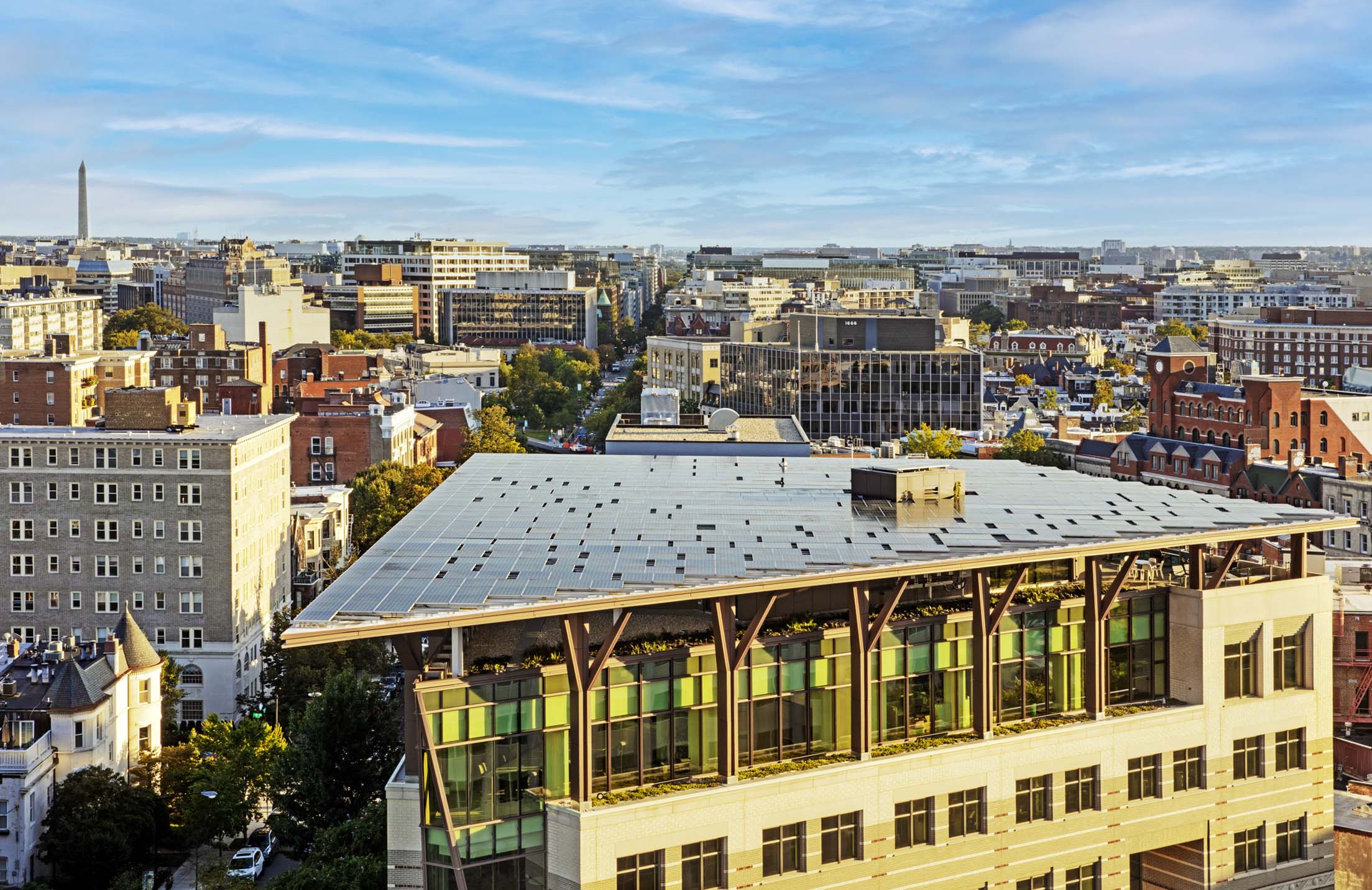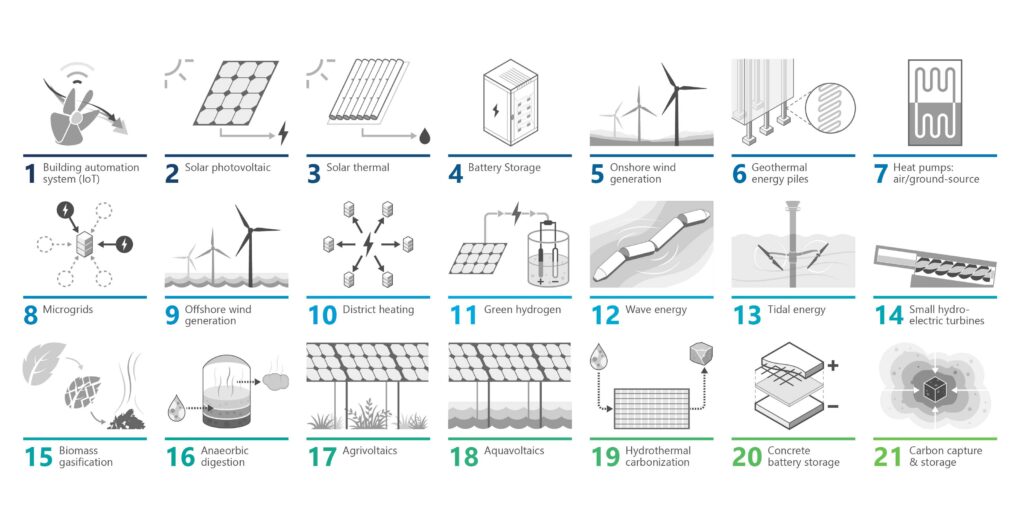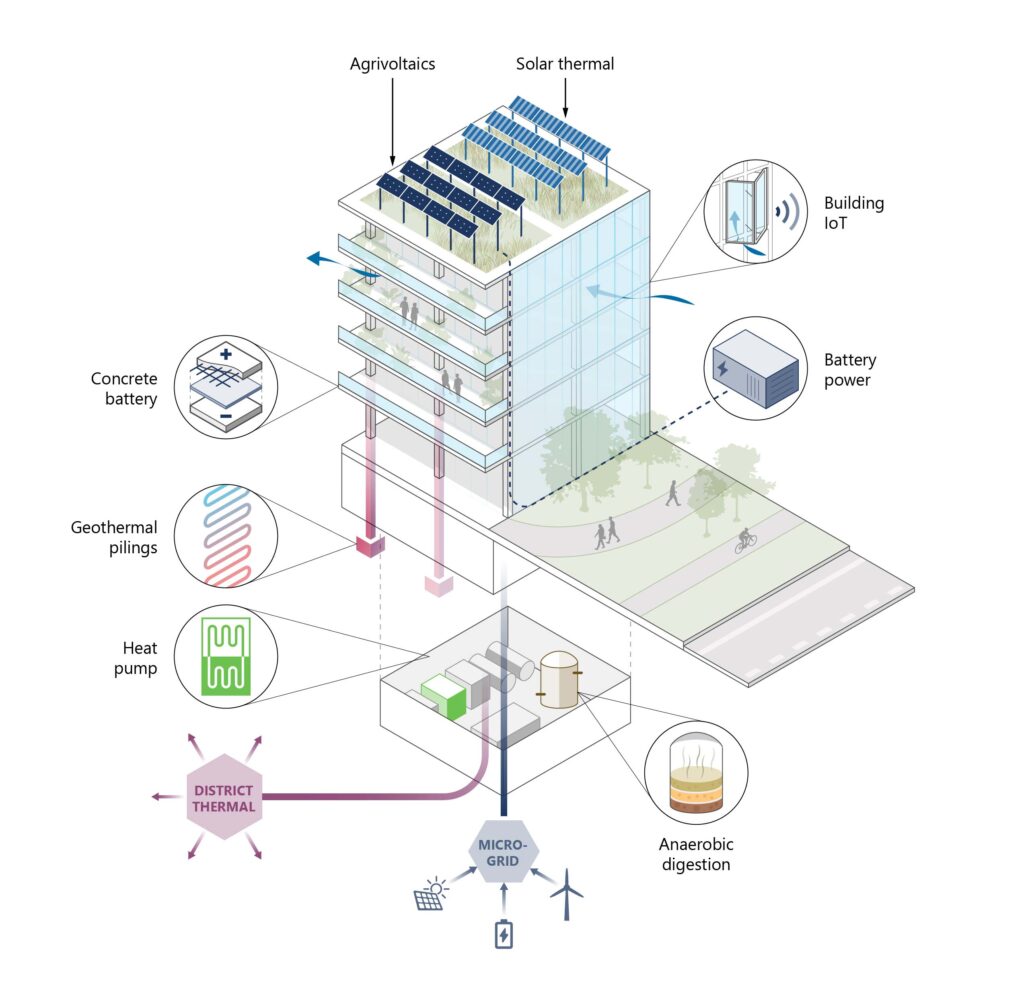
| Nov 30, 2022
Innovations in Renewable Energy Production
Four Top Trends from AEC Industry Experts HITT Contracting and Buro Happold
New net zero energy targets set by jurisdictions across the United States have put a pressing imperative on the AEC industry to deliver higher-performing spaces for clients. In response, HITT’s research and development team conducted preliminary research with international, integrated consultancy of engineers Buro Happold to identify current trends and future innovations in on-site renewable energy production technologies.
The result of this research was a comprehensive library of 21 technologies in the five areas of energy production, storage, distribution, recovery, and carbon technology. The study strategically identified the latest innovations in on-site renewable energy production of established technologies like solar, wind, and geothermal. It specifically looked at advancements in Europe and Asia that will likely see adoption throughout the US in the coming years. Additionally, the study uncovered new laboratory-stage technologies like concrete battery storage and collocated geothermal structural piles that have the potential for adoption.

Building from this extensive renewable energy research, HITT hosted a Masters Series panel of engineers, architects, and building performance specialists to share the practical opportunities and challenges in leveraging renewable energy production and storage technologies. The panelists outlined thoughtful conversations around the critical components to achieving new energy targets, trends in the US renewable energy market, and the shifting behaviors in adopting more sustainable on-site energy solutions. Outlined below is a summary of the four key takeaways.
#1 Building Type and Regional Differences
It’s critical to not think about renewable energy as a one-size-fits-all, but rather consider the building type and location.
- Some building types require off-site renewable energy production strategies. Hospitals, zero lot line structures, and tall buildings can’t produce all energy on-site. Community-based solutions are needed to share distributed energy. Schools with large land areas, for example, can serve as a community renewable energy facility for nearby housing.
- Market rate net zero ready buildings are already being built. In the Washington, DC metro area and in many other US markets, we’re seeing market rate buildings at or near energy usage targets. Now it’s just a matter of bringing the renewable technologies to the site.
- Net-metering caps restrict energy goals in some parts of country. In some areas of the US, there is a cap of energy that can be produced on-site. This includes restrictions on how much can be net-metered, not allowing for full net zero buildings.
- The US grid is highly diverse in how much emissions it takes to produce energy. Energy grids and fuel mixes vary in different parts of the country. Some fuel sources have higher emissions factors in how energy is produced, so on-site energy production is even more impactful or restrictive.
#2 Advancements in Renewable Energy Innovation
There is significant advancement and investment in renewable energy production.
- Significant rise of investment in battery technology. As battery technology rapidly evolves with the rise of electrical vehicles, battery systems are dropping in price. Current lithium-ion battery technology has capacity limit challenges, but further investment in redux flow technology is expanding the ability to scale up battery storage. Looking globally in 2021, the global energy sector accounted for $36B in investment, up 260% from 2020 according to CB Insights’ 2021 Global State of Energy Report.
- Technology doesn’t need to be advanced; it must be applied in smart ways. In office buildings and schools, photovoltaic, or PV, panels over water (aquavoltaics), over plants (agrovoltaics), and heat pumps are all established technologies. What’s needed is the right team rallied around the right goal to smartly integrate systems.

#3 Client Sentiment and Financial Incentives
A combination of the drop in the price of renewable energy, financing options, and shifts in financial incentives is making renewable energy more attractive than ever.
- There’ve been steady increases around renewable adoption. Clients are asking about renewables now more than ever. It’s more than just achieving net zero, but also about decarbonization.
- Price drops and investment targets are changing attitudes. A rapid drop in the price of PV has increased adoption and net zero awareness, resulting in increased adoption.
- Power Purchase Agreements (PPA) and alternative financing spread costs. Alternative financing options are now available, allowing owners to forgo bearing the full cost. Through the Inflation Reduction Act further tax deductions (179D tax credit) drives energy retrofit incentives from $1.80 up to $5 per square foot.
#4 A Smart Path Forward
It’s critical to rally clients and project teams around a central goal of renewable energy.
- Encourage peer-to-peer discussions. Find companies already using an alternative energy technology and discuss their experience. Talk to building engineers regarding the opportunities and challenges of its everyday use.
- Bring together diverse stakeholder groups early. Bring contractors into the discussion early to understand supply chain and constructability issues that can be avoided.
- Consider supply chain challenges. Electrical components of alternative energy systems can delay installation by months, so consider options and plan as early as possible. Also, emerging technologies can be more susceptible to supply chain issues because emerging tech has can have minimal suppliers.
Co-published by HITT Contracting & Buro Happold
To watch the full Masters Series panel discussion, click here.
Speakers included:
- Michelle Amt, Director of Sustainability, VMDO Architects
- Roger Chang, Principal, Buro Happold
- Sam Coats, Research & Development Manager, HITT Contracting
- Anica Landreneau, Sustainable Design Director, HOK
Interested in learning more or starting a conversation about net zero or renewable energy? Contact Megan Lantz, Vice President of Research & Development.

